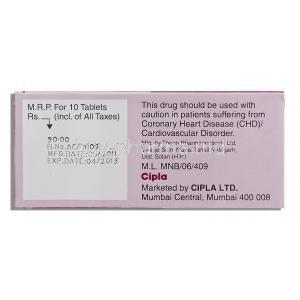Etoricoxib
- I. Introduction
- II. Etoricoxib: Composition and Structure
- III. Etoricoxib: Mechanism of Action
- Primary Uses of Etoricoxib
- Off-label Use of Etoricoxib
- VI. Dosage and Administration of Etoricoxib
- VII. Special Considerations in Etoricoxib Administration
- VIII. Etoricoxib: Possible Side Effects and Adverse Reactions
- IX. Overdosage of Etoricoxib: Symptoms and Management
- X. Etoricoxib Interactions
- XI. Warnings and Contraindications for Etoricoxib Use
- XII. Storage and Handling Precautions for Etoricoxib
- XIII. Future Prospects and Research on Etoricoxib
I. Introduction
A. Overview of Etoricoxib
Etoricoxib, a medication categorized as a COX 2 inhibitor and a nonsteroidal anti-inflammatory drug (NSAID), is commonly prescribed to individuals suffering from different kinds of arthritis and acute pain conditions. It is highly acclaimed for its effectiveness in reducing both pain and inflammation, making it an essential component in managing symptoms associated with long-term ailments.
B. Brief History of Etoricoxib Development
Etoricoxib's journey began in the 1990s as part of an ambitious project to develop specialized pain relief medications. Merck & Co. Inc., a global pharmaceutical company, spearheaded its development. By the 2000s, Etoricoxib received regulatory approval in various countries, steadily earning its reputation as a significant contender in pain management.
C. Role of Etoricoxib in Modern Medicine
Etoricoxib is highly regarded in the field of medicine today. It is commonly prescribed for treating conditions, including osteoarthritis, rheumatoid arthritis, ankylosing spondylitis, and gouty arthritis, as well as for managing short-term pain and inflammation resulting from dental or orthopedic surgeries. Its exceptional qualities have made it a preferred choice among healthcare professionals worldwide.
II. Etoricoxib: Composition and Structure
A. Chemical Composition of Etoricoxib
Etoricoxib, also known by its chemical name 5 chloro 6' methyl 3 [4 (methylsulfonyl)phenyl] 2,3' bipyridine, has the formula C18H15ClN2O2S. This formula represents the combination of elements it contains.

B. Structure and Key Characteristics
Etoricoxib is composed of two pyridine rings containing nitrogen compounds connected to a phenyl group. This molecule has physical and chemical characteristics, such as notable solubility in lipids, which play a role in its effectiveness in pharmacological applications.
III. Etoricoxib: Mechanism of Action
A. How Etoricoxib Works at the Molecular Level
Etoricoxib works by targeting an enzyme called cyclooxygenase 2 (COX 2) which is involved in converting arachidonic acid to prostaglandins. By inhibiting COX 2, Etoricoxib reduces the production of these prostaglandins resulting in pain relief and reduced inflammation throughout the body.
B. Impact of Etoricoxib on Inflammatory Processes
Etoricoxib effectively reduces inflammation by inhibiting the response mediated by prostaglandins. It decreases the synthesis of prostaglandins such as PGE2, PGF2α, and PGI2, which are essential contributors to the development of inflammation. As a result, it decreases swelling, pain, and redness in the areas.
C. Etoricoxib and Pain Management
Etoricoxib effectively controls pain by regulating the release of prostaglandins. Specifically, it targets PGE2, which is responsible for sensitizing pain receptors or nociceptors. By reducing the production of these prostaglandins, Etoricoxib effectively prevents the activation of these nociceptors, decreasing the pain sensation. This demonstrates its effectiveness as a pain reliever.
Primary Uses of Etoricoxib
Etoricoxib in Osteoarthritis Treatment
Etoricoxib is a nonsteroidal inflammatory drug (NSAID) that is commonly prescribed for the treatment of osteoarthritis. It works by alleviating both inflammation and joint pain. Etoricoxib is often recommended when other pain relievers like paracetamol or ibuprofen have proven ineffective or are deemed unsuitable. It has demonstrated efficacy in reducing pain and inflammation among individuals suffering from osteoarthritis. One notable advantage of Etoricoxib is its once-a-day dosage making it a convenient option compared to other NSAIDs. Additionally, studies have indicated that Etoricoxib carries a lower risk of gastrointestinal side effects compared to alternative NSAIDs.
Here are the references for the information provided:
Etoricoxib in Rheumatoid Arthritis Treatment
Etoricoxib is also prescribed for the treatment of arthritis, an autoimmune condition that leads to joint inflammation. This medication works by alleviating pain and reducing inflammation in the joints. Additionally, Etoricoxib has proven effective in managing pain and inflammation in patients with rheumatoid arthritis. What sets Etoricoxib apart is its once-a-day dosing regimen, which offers convenience compared to other NSAIDs. Moreover, studies have demonstrated that Etoricoxib carries a lower risk of gastrointestinal side effects when compared to other NSAIDs.
Here are the references for the information provided:
Etoricoxib in Ankylosing Spondylitis Treatment
Ankylosing spondylitis is a form of arthritis that specifically targets the spine. To alleviate inflammation and joint pain associated with spondylitis, doctors often prescribe etoricoxib. This medication proves effective in providing relief for both pain and inflammation in individuals with spondylitis. An added convenience of etoricoxib is that it only needs to be taken once a day, making it more user-friendly compared to other NSAIDs. Moreover, studies have shown that etoricoxib reduces the risk of side effects compared to other NSAIDs.
Here are the references for the information provided:
Etoricoxib for Acute Gout
Acute gout, a form of arthritis, can cause intense pain, swelling, and redness in the joints. Etoricoxib is a medication that alleviates the pain and inflammation associated with acute gout. It is known to be effective in providing relief for patients experiencing acute gout symptoms. One of the advantages of using Etoricoxib is that it only needs to be taken once a day, making it more convenient in comparison to other NSAIDs. Additionally, research has indicated that Etoricoxib has a lower risk of causing gastrointestinal side effects than other NSAIDs.
Here are the references for the information provided:
Off-label Use of Etoricoxib
Unapproved Yet Common Applications of Etoricoxib
Etoricoxib is a medication known as a nonsteroidal inflammatory drug (NSAID). It is commonly prescribed to patients with osteoarthritis, rheumatoid arthritis, ankylosing spondylitis, and acute gout. From these approved uses, etoricoxib is also prescribed off-label for various other conditions, including chronic low back pain, chronic musculoskeletal pain, postoperative pain, dysmenorrhea, migraine, acute dental pain, acute renal colic, acute sciatica, acute ankle sprain, and acute shoulder pain.
Here are the references for the information provided:
Clinical Studies Supporting Off-label Use of Etoricoxib
Research conducted in medical journals has demonstrated the effectiveness of etoricoxib in treating a range of conditions. For instance, a study published in the Journal of Pain Research revealed outcomes in using etoricoxib for chronic low back pain reduction. Furthermore, the Journal of Rheumatology featured a study showcasing the efficacy of etoricoxib in alleviating musculoskeletal pain. Another study published in the Journal of Clinical Anesthesia highlighted etoricoxib as a pain management option for postoperative cases. In addition, the Journal of Obstetrics and Gynaecology Research reported on the impact of etoricoxib in reducing dysmenorrhea. At the same time, the Journal of Headache and Pain recognized its efficacy in mitigating migraines. Such research supports the benefits of etoricoxib across multiple medical domains.
Here are the references for the information provided:
VI. Dosage and Administration of Etoricoxib
A. Standard Dosage Guidelines for Adults
The recommended amount of Etoricoxib for adults varies depending on the condition being addressed. It is usually advisable to take a daily dose of 60mg for conditions like osteoarthritis. However, for acute conditions such as gouty arthritis, a higher dosage of 120mg per day is commonly prescribed. It's important to emphasize that surpassing these dosages within a 24-hour is not recommended.
B. Modifications in Dosage for Specific Conditions
Although the information mentioned earlier gives a guideline, there are situations where the dosage needs to be adjusted. For example, If a patient has liver problems, it is recommended to lower the dose to 60mg in severe cases. Generally, patients with kidney issues don't need to change the dosage unless complicating factors are involved. These modifications emphasize the significance of assessing each patient to determine the proper Etoricoxib dosage.
C. Correct Administration Techniques
Etoricoxib is usually taken by mouth. The tablets should be swallowed whole with a glass of water. You can take them with or without food. Taking Etoricoxib at a time that aligns with your symptoms is essential to ensure maximum effectiveness. Remember not to exceed the duration your healthcare professional prescribes when using Etoricoxib.
VII. Special Considerations in Etoricoxib Administration
A. Administration to the Elderly
In individuals, it is essential to take a careful approach when administering Etoricoxib. Because aging comes with changes that can affect things like kidney function, the body may take longer to eliminate Etoricoxib leading to higher levels in the bloodstream. That's why it's crucial to start treatment with the dose possible and keep a close eye on how the patient responds.
B. Administration to Pregnant Women and Nursing Mothers
It is advisable to avoid using Etoricoxib during pregnancy in the later stages as it may pose a risk of uterine inertia and premature closure of the ductus arteriosus. In the case of breastfeeding women, although it is uncertain whether Etoricoxib is present in breast milk, it is recommended to exercise caution due to its inhibitory impact on prostaglandin synthesis.
C. Administration to Children
Etoricoxib should not be used in children or teenagers below 16 years since there is insufficient data on its safety and effectiveness. If there's any consideration of using it in this age group, a thorough evaluation of the risks and benefits should be conducted.
VIII. Etoricoxib: Possible Side Effects and Adverse Reactions
A. Common Side Effects of Etoricoxib
Similar to any medication, Etoricoxib can have specific side effects, although not everyone experiences them. The frequently mentioned side effects are dizziness, headaches, stomach pain or discomfort, diarrhea or constipation, dyspepsia (indigestion), and palpitations. However, these symptoms are usually mild. Tend to improve as the body adjusts to the medication with continued use.
B. Infrequent But Severe Side Effects
Although it is not very common there are instances where Etoricoxib can cause side effects. These may include elevated potassium levels in the blood (known as hyperkalemia) high blood pressure (hypertension) swelling under the skin (angioedema) serious skin reactions and gastrointestinal issues, like ulcers and bleeding. If any of these symptoms occur it is essential to seek medical attention.
C. Managing Side Effects and Adverse Reactions
If you experience any side effects, informing your healthcare provider is crucial. Managing these side effects may involve making adjustments to the dosage providing supportive treatments, or in rare cases discontinuing the medication. Remember, it is vital to consult your healthcare provider before making any changes to your dosage or deciding to stop taking Etoricoxib.
IX. Overdosage of Etoricoxib: Symptoms and Management
A. Recognizing Symptoms of Etoricoxib Overdosage
Taking much Etoricoxib can intensify the side effects. You might experience stomach pain, nausea, dizziness, tiredness, feeling confused, or even slip into a coma. If you notice any signs of an overdose it's essential to seek medical help.

B. Immediate Steps to Take in Case of Overdosage
If you suspect an overdose of Etoricoxib, it is crucial to contact a healthcare professional or poison control center immediately. The appropriate action, such as inducing vomiting or performing lavage, will be determined based on the timing of ingestion and the patient's overall condition. Additionally, it is essential to provide care and address any symptoms that may arise.
C. Long-term Implications of Etoricoxib Overdosage
The long-term consequences of taking much Etoricoxib depend on various factors, such as the amount ingested, the person's overall health, and how quickly they receive treatment. If someone takes an amount for a prolonged period, it could result in severe problems like bleeding in the stomach or intestines, kidney damage, or even heart-related issues. That's why it's crucial to address any concerns or suspicions of an overdose thoroughly.
X. Etoricoxib Interactions
A. Known Drug Interactions with Etoricoxib
It is essential to know that Etoricoxib may interact with other medications. These interactions can potentially affect its effectiveness. Lead to an increased likelihood of experiencing side effects. Some medications known to interact with Etoricoxib include; Anticoagulants like warfarin; Etoricoxib can raise the risk of bleeding when used with these medications. Diuretics and ACE inhibitors, Etoricoxib, can diminish these medications' effectiveness, potentially worsening heart failure or hypertension. Lithium; Taking Etoricoxib alongside lithium can cause an increase in lithium levels leading to toxicity. To ensure your safety and the possible outcome, it is crucial to inform your healthcare provider about all the medications you are taking before starting Etoricoxib.
B. Etoricoxib Interactions with Food and Beverages
While you're taking Etoricoxib, there are no foods that you need to steer clear of. However, it's advisable to avoid drinking amounts of alcohol as it may raise the chances of developing stomach ulcers and gastrointestinal bleeding.
C. Impact of Underlying Health Conditions on Etoricoxib Interactions
Certain medical conditions can impact how the body reacts to Etoricoxib. For example,, people with liver or kidney diseases may require adjustments in their dosage because their body's ability to metabolize the drug can be different. Likewise, individuals with a history of heart disease or stroke should be careful when using Etoricoxib as there could be a higher chance of experiencing cardiovascular events.
XI. Warnings and Contraindications for Etoricoxib Use
A. Health Conditions that Prohibit Etoricoxib Use
There are some situations in which the use of Etoricoxib is not recommended. These situations include having a peptic ulcer or gastrointestinal bleeding, severe liver disease, a history of heart failure or stroke, or known hypersensitivity to Etoricoxib. In these cases, there is a risk of experiencing severe adverse reactions if Etoricoxib is used.
B. Situations Requiring Caution when Using Etoricoxib
Although it is not considered wholly prohibited, there are specific circumstances where it is advisable to proceed cautiously. These situations consist of individuals who have had gastrointestinal issues with hypertension or heart conditions, elderly patients, and individuals who have a history of asthma or other allergies. In instances, it is essential to thoroughly evaluate the risks and benefits involved and maintain close supervision throughout the process.
C. Important Precautions for Safe Etoricoxib Use
To make sure you use Etoricoxib safely, it's crucial to follow the instructions given by your healthcare provider. Keep an eye out for any side effects. Be sure to report any new or unusual symptoms promptly. It's important to have checkups to adjust the dosage if needed and assess the effectiveness of the medication. Lastly, don't forget to attend all your scheduled liver function tests or appointments for monitoring as your healthcare provider recommends.
XII. Storage and Handling Precautions for Etoricoxib
A. Ideal Storage Conditions for Etoricoxib
To maintain the quality of Etoricoxib, it is recommended to store it in a dry place with a temperature of less than 30°C (86°F). It should be kept in its packaging until it is ready for use to safeguard it from moisture. Avoid storing it in the bathroom or near a sink, and ensure it is out of reach and sight of children.
B. Handling Precautions for Etoricoxib
When using Etoricoxib tablets, handling them with dry hands is essential. It is advised not to break, crush or chew the tablets. Instead, swallow them whole with a glass of water. Always follow the instructions provided by your healthcare provider when handling the medication.
C. Proper Disposal of Etoricoxib
It is advisable not to throw unused or expired Etoricoxib tablets in wastewater or household waste to protect the environment. Instead, please consult your pharmacist on disposal methods for no longer-needed medications. Taking these steps will contribute to safeguarding the environment.
XIII. Future Prospects and Research on Etoricoxib
A. Ongoing Clinical Trials on Etoricoxib
Currently, there are clinical trials to explore the safety, effectiveness, and potential additional applications of Etoricoxib. These studies seek to enhance our knowledge of where Etoricoxib fits within treatment plans in addressing different pain conditions and inflammatory diseases.
B. Potential Future Applications of Etoricoxib
Etoricoxib has the potential to go beyond its approved uses. Early studies indicate it might help treat conditions like fibromyalgia, migraines, and even cancer-related pain. However, it's important to note that these potential applications are still in the phase, and more extensive clinical trials are necessary to validate these effects.
C. Closing Remarks on Etoricoxib's Role in Medicine
To sum it up, Etoricoxib proves to be an asset in managing pain and inflammation that can arise from different conditions. Its distinct way of working and its safety record make it a preferred option for groups of patients. Although there are concerns about side effects and interactions with careful usage and diligent monitoring, Etoricoxib can significantly enhance patients' quality of life. As we continue exploring its possibilities, Etoricoxib is likely to play a more significant role in medicine, bringing relief to a more significant number of patients in the times ahead.
Etoricoxib FAQ
- Etoricoxib equivalent in USA?
- What is Etoricoxib 90 mg?
- Can I buy Etoricoxib over the counter?
- Etoricoxib price?
- Etoricoxib kaufen?
- Etoricoxib OTC?
- Buy Etoricoxib online?
- Is Etoricoxib anti-inflammatory?
- Etoricoxib cost UK?
- Is Etoricoxib banned in UK?
- Etoricoxib genérico?
- Etoricoxib cost?
- Etoricoxib para que sirve?
- Etoricoxib 90?
- Etoricoxib 120 mg?
- Etoricoxib paracetamol tablet uses in Hindi?
- Etoricoxib 120?
- Etoricoxib 90 mg?
- Etoricoxib tablet?
- Etoricoxib uses?
- Etoricoxib side effects?
- Etoricoxib indication?
- Etoricoxib zentiva 120 mg?
- Etoricoxib composition?
- Etoricoxib tablet uses?
- Etoricoxib 60 mg?
- Etoricoxib brand name?
- Etoricoxib Hindi?
- Etoricoxib efectos secundarios?
- Etoricoxib dosage?
- Etoricoxib dose?
- Etoricoxib precio?
- Etoricoxib Arcoxia?
- Etoricoxib in English?
- Etoricoxib vs Celecoxib?
- Xumer Etoricoxib 90 mg?
- What is Etoricoxib?
- Can Etoricoxib cause high blood pressure?
- Etoricoxib vs Ibuprofen?
- Etoricoxib and Thiocolchicoside?
- Etoricoxib over the counter?
- Etoricoxib Español?
- Etoricoxib dosis?
- Etoricoxib para que es?
- What is Etoricoxib 120 mg used for?
- Etoricoxib vs Naproxen?
- Etoricoxib and Thiocolchicoside tablets uses?
- Etoricoxib and alcohol?
- Etoricoxib generic name?
- Etoricoxib brand name in USA?
- Etoricoxib medicine?
- Etoricoxib medication?
- Etoricoxib PLM?
- How strong is Etoricoxib?
- How long does Etoricoxib last?
- What Etoricoxib used for?
- What is Etoricoxib 60 mg used for?
- What does Etoricoxib treat?
- What does Etoricoxib do?
- What is Etoricoxib prescribed for?
- Etoricoxib when to take?
- Why is Arcoxia banned in the US?
- Etoricoxib how to take?
- How long Etoricoxib can be taken?
- How quickly does Etoricoxib work?
- Which is better Etoricoxib or Celecoxib?
- What are Etoricoxib Teva tablets for?
- Can Etoricoxib damage kidneys?
- Can Etoricoxib be used for headache?
- Can Etoricoxib be taken at night?
- Can Etoricoxib cause weight gain?
- Can Etoricoxib be used for toothache?
- Etoricoxib is NSAID?
- Is Etoricoxib a strong painkiller?
- Is Etoricoxib safe for kidneys?
- Is Etoricoxib safe in pregnancy?
- Etoricoxib time to work?
- Etoricoxib for headache?
- Etoricoxib for toothache?
- Etoricoxib for back pain?
- Etoricoxib for gout?
- Etoricoxib for dental pain?
- Etoricoxib for period pain?
- Etoricoxib for knee pain?
- Etoricoxib for neck pain?
- Etoricoxib for fever?
- Etoricoxib for sore throat?
- Etoricoxib for dogs?
- Etoricoxib for pain?
- Etoricoxib for ear pain?
- Etoricoxib for nerve pain?
- Etoricoxib with Ibuprofen?
- Etoricoxib with Paracetamol?
- Etoricoxib with Thiocolchicoside?
- Etoricoxib with Serratiopeptidase tablets uses?
- Etoricoxib with alcohol?
- Etoricoxib with or without food?
- Etoricoxib with Serratiopeptidase tablets?
- Etoricoxib with Thiocolchicoside uses?


























































